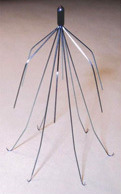Researchers, FDA warn about IVC filters
by
Heather Mayer, DOTmed News Reporter | August 11, 2010

Doctors and patients
told to be
cautious.
In two separate reports, cardiologist Dr. William Nicholson and the U.S. Food and Drug Administration reported concern for inferior vena cava (IVC) filters, largely manufactured by Bard Peripheral Vascular.
The FDA began looking at the small, cage-like devices used to protect against pulmonary embolism (PE) for the short term in January after reports of problems with the class of IVC filters, said Dr. Bram Zuckerman, director of cardiovascular devices for the FDA. Nicholson published his report Monday in the Archives of Internal Medicine, reporting 16 percent of the filters in patients studied had fractured. Of these, 25 percent fractured and traveled through the vein.
A report from the FDA stated that since 2005, the agency has received 921 device adverse event reports involving IVC filters. Of these reports, 328 involved device migration; 146 involved embolizations - detachment of device pieces; 70 involved perforation of the IVC; and 56 involved filter fracture.
"Some of these events led to adverse clinical outcomes in patients," the FDA wrote.
But Zuckerman and the FDA were quick to point out that the Class II relatively low-risk devices are safe and effective when used within their intended labeling. That is, in many cases, these devices are only intended for temporary use to decrease the risk of PE.
"The FDA recommends that implanting physicians and clinicians responsible for ongoing care of patients with retrievable IVC filters consider removing the filters as soon as protection from PE is no longer needed," said Zuckerman.
After a case of a fractured filter, York Hospital-based Nicholson studied 189 patients who had received a Bard Recovery or a Bard G2 vena cava filter at his institution between April 2004 and January 2009. The devices' arms and legs from the Bard Recovery reportedly fell off in some patients, and in September 2005, the company changed the design to improve the devices' resistance to fracture. The modified Bard G2 filter has been implanted in more than 65,000 patients since September 2005.
The researchers also discovered that even though the Bard G2 filter was created to reduce problems caused by the Bard Recovery, 12 percent of the Bard G2s also fractured. In two of these cases, the fragment blocked blood flow, one in the vein leading from the liver and one in the lungs.
Nicholson told DOTmed News he was open with the FDA during his research.
"The FDA has known all along," Nicholson said, regarding his findings. "They've been preparing a statement."
Although the IVC filters are classified as Class II devices, Zuckerman pointed out that they underwent "rigorous" evaluation before approval. The IVCs required detailed engine testing, detailed bench testing, chronic animal performance and human clinical trials, explained Zuckerman.
"Even though the device is technically a Class II device, rather than a Class III, the FDA has the authority to ask for the proper data needed before making any regulation decisions," he said.
The findings of Nicholson's study and the government watchdog's own research will most likely lead to changes in the preclinical evaluation, clinical evaluation and market surveillance of the IVC devices, Zuckerman said.
"We expect in the near future that changes will be made in all three of these aspects to this particular device," he said.
Bard Peripheral Vascular did not return calls for comment.
